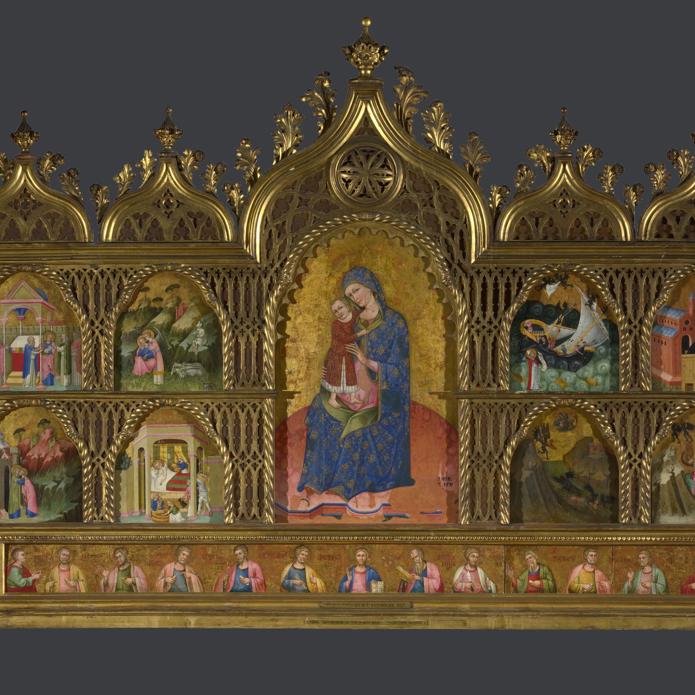Dalmatian/Venetian, 'Helsinus saved from a Shipwreck; A French Canon drowned', about 1400
About the work
Overview
These scenes come from a text written in twelfth century by an English monk called Eadmer, an early supporter of the idea that the Virgin was conceived without sin; they conclude in Helsinus Preaching the Celebration of the Feast of the Conception and (below) The French Canon restored to Life.
The upper scene shows a violent shipwreck. Devils tear at the sails and break the mast. The English abbot Helsinus prays for salvation, while the crew throws excess cargo into the waves. A bishop saint appears; he stands upon the water and holds a scroll bearing words in Latin: ‘You will escape death if you celebrate the Feast of the Conception of the Virgin on the sixth day before the Ides of December.’
In the lower scene, devils drown a French canon in the river Seine as he returns from an adulterous liaison. He lies in the water and two devils remove his soul from his mouth. At this same moment the Virgin, surrounded by angels, intervenes: at her command, an angel swoops down.
Key facts
Details
- Full title
- Helsinus saved from a Shipwreck and (below) A French Canon drowned by Devils
- Artist
- Dalmatian/Venetian
- Part of the group
- Altarpiece of the Virgin Mary
- Date made
- about 1400
- Medium and support
- egg tempera on wood
- Dimensions
- 64 × 27.5 cm
- Inscription summary
- Inscribed
- Acquisition credit
- Bequeathed by H.E. Luxmoore, 1927
- Inventory number
- NG4250.4
- Location
- Not on display
- Collection
- Main Collection
- Previous owners
Provenance
Additional information
Text extracted from the ‘Provenance’ section of the catalogue entry in Dillian Gordon, ‘National Gallery Catalogues: The Italian Paintings before 1400’, London 2011; for further information, see the full catalogue entry.
Bibliography
-
1951Davies, Martin, National Gallery Catalogues: The Earlier Italian Schools, London 1951
-
1986Davies, Martin, National Gallery Catalogues: The Earlier Italian Schools, revised edn, London 1986
-
1988Gordon, Dillian, National Gallery Catalogues: The Early Italian Schools before 1400, revised edn, London 1988
-
2001
C. Baker and T. Henry, The National Gallery: Complete Illustrated Catalogue, London 2001
-
2011Gordon, Dillian, National Gallery Catalogues: The Italian Paintings before 1400, London 2011
About this record
If you know more about this work or have spotted an error, please contact us. Please note that exhibition histories are listed from 2009 onwards. Bibliographies may not be complete; more comprehensive information is available in the National Gallery Library.
Images
About the group: Altarpiece of the Virgin Mary

Overview
This altarpiece is a unique example in the National Gallery’s collection of a work made by a late medieval artist working on both sides of the Adriatic, the sea between Italy and the Balkan coast. The picture may be one of the earliest painted representations of the Virgin of the Immaculate Conception (the Virgin being conceived without sin). This was a controversial idea in this period. It was not officially included in Catholic theology until the nineteenth century, but it was celebrated in the fifteenth century, on 8 December.
The central panel showing the Virgin and Child includes celestial bodies – the sun, moon and stars – that became associated with the Immaculate Conception. The left side panels show the story of the Virgin’s miraculous birth to a couple who could not have children; the right side panels shows two miracles of the Virgin.








